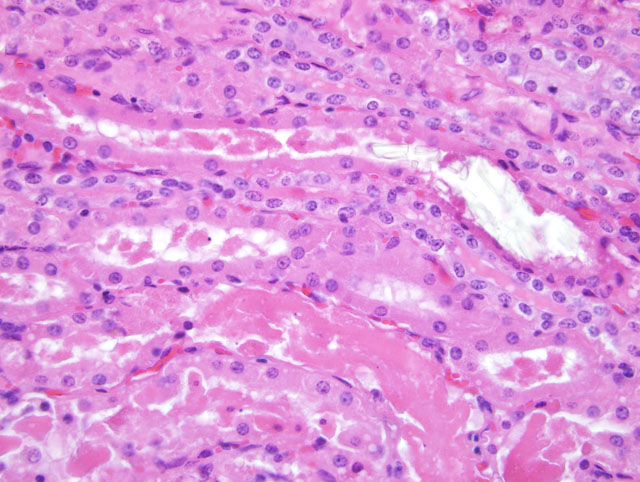Signalment:
3-year-old, female, Rambouillet, (
Ovis aries)This animal was one from a herd of approximately 1200 sheep on open range in the Four Corners region
of northwestern New Mexico. During a winter snowstorm in the area, the shepherd moved the animals from the
mesa tops down into surrounding lower country (arroyos, valleys). During the day and night following the move, it
had snowed approximately 8 inches. The following morning the shepherd found 50 animals dead and 5 animals that
were down, debilitated, and showing neurological signs. The water source was snow; sheep were ranged on the
country described above. Trace mineral salt was supplemented. The shepherd was with sheep at all times.
Gross Description:
This ewe was presented alive, but down, and with neuromuscular fasciculations of the head and
neck. The animal was unable to get up, and was euthanized. On gross exam, the rumen was engorged with a
somewhat woody or brushy type plant material; this had a somewhat pungent odor. Both the rumen and reticulum
were somewhat edematous. The kidneys were pale, swollen and bulged on cut surface.
Histopathologic Description:
The kidneys had flattening and destruction of proximal convoluted tubular epithelial
cells, with prodigious aggregates of birefringent crystals in these tubules. These crystals also were seen in distal
convoluted tubules, but in much lower numbers. Crystals had layers or sheaves aggregated together; these were
consistent with oxalates histologically.
Morphologic Diagnosis:
Nephrosis, toxic tubular, kidney, ovine due to potassium oxalate
intoxication from excessive ingestion of greasewood (
Sarcobatus vermiculatus).
Condition:
Oxalate nephrosis
Contributor Comment:
Brushy plants found in the rumen were identified as greasewood (
Sarcobatus
vermiculatus), a plant commonly found in the western and Southwestern range country. This is a plant browsed
extensively by sheep, usually without any problems when eaten in combination with other forages. However, when
eaten as an exclusive diet (and thus in excess), it is highly toxic and can cause massive die-off, such as with this
case. In this particular situation, greasewood was the only browse poking thru the recent snowfall, and sheep are not
prone to paw or dig for forage like cattle. Hence, in this circumstance of weather, terrain, and ready availability of a
poisonous plant, coupled with grazing habits of sheep, a perfect storm of all the above ingredients resulted in the
excessive ingestion of
Sarcobatus spp. and subsequent intoxication and die-off of animals. The shepherd had moved
the sheep into a fenced pasture and put out high grade alfalfa hay prior to bringing this animal in for necropsy, as he
was suspicious of greasewood being the cause of the problem. A few more animals died, but the change in diet
resolved any further problem.
Histologic lesions are quite similar to those of antifreeze (ethylene glycol) intoxication in a number of species;
however, these are potassium oxalates with the
Sarcobatus spp. intoxication, versus calcium oxalates crystals seen
with antifreeze poisoning. Histologically, the lesions and crystals are very similar.
Sarcobatus spp. contains a mixture of neutral sodium and potassium oxalates - about 10-15% d.w. in leaves and in
smaller amounts in stems and fruits. Oxalate concentrations reach a peak in early fall. Aqueous extracts of the plant
containing 40% oxalates, when given to sheep, produced the same signs and lesions as when the plant was eaten.(1)
Other oxalate producing plants that can cause poisoning in sheep and cattle include halogeton (
Halogeton
glomeratus), common rhubarb (
Rheum rhaponticum), soursob (
Oxalis cernua), and sorrel dock (
Rumex spp).(2)
JPC Diagnosis:
Kidney: Tubular necrosis, acute, diffuse, with intratubular oxalate crystals.
Conference Comment:
Case discussion focused on the pathogenesis of oxalate nephrosis in animals. Sheep are
able to consume oxalate-containing plants without toxicity due to the rumens ability to metabolize oxalates to
bicarbonate and carbonate; however, changes in the microbial balance of the rumen may reduce this ability. In this
case, unmetabolized oxalates are absorbed into the circulation where they chelate calcium ions, and thus forming
insoluble calcium oxalate complexes. In the kidney, these complexes may crystallize in vessel walls, or within the
lumens of blood vessels or renal tubules. Deposition within vessels results in renal hemorrhage and necrosis, while
deposition in renal tubules results in obstruction and acute renal failure. Furthermore, intracellular chelation of
calcium and magnesium ions may interfere with oxidative phosphorylation, resulting in nephrotoxicity in addition to
physical tubular obstruction.(2)
Electrolyte disturbances in affected animals include increased plasma sodium, potassium and calcium; of these
changes, the cadiotoxic potential of hyperkalemia is most life-threatening. In addition, ingestion of oxalatecontaining
plants by sheep results in hypocalcemia due to chelation and may result in tetany. Acidosis and azotemia
are other common clinicopathologic findings in acute renal failure, with acidosis in affected animals often being the
most significant contributory factor in the cause of death.(2)
References:
1. Burrows GE, Tyrl RJ. Chenopodiaceae vent. In:
Toxic Plants of North America. 1st ed. Ames, IA: Iowa State
University Press; 2001:358-359.
2. Maxie MG, Newman SJ. Urinary system. In: Maxie MG, ed.
Jubb, Kennedy and Palmers Pathology of Domestic
Animals. 5th ed., vol. 3. Philadelphia, PA: Elsevier Ltd; 2007:432-433, 470-472.
